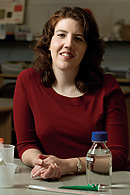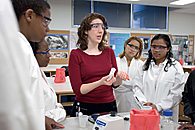Life Science

Twelve teenagers shuffle into Biogen Idec’s Community Lab in Cambridge, Mass. They’ve traveled across the Charles from an alternative Boston public school whose at-risk students include many expelled from their previous schools and others euphemistically “deemed to need alternative placement.”
Tracy Callahan ’91 (left) instructs them to sit at one of the gray-topped lab tables, which they do with a considerable amount of giggling and nudging. What does a biotech company do, Callahan asks. What goes on at Biogen Idec? A lanky guy in a white T-shirt and baggy jeans replies “bio stuff,” then chuckles.
Callahan is unfazed. Within five minutes she’s lured in the comedian and his 11 compeers, and is eliciting enthusiastic responses to a series of questions about sickle-cell anemia, the lead-in to a lab called “The Mystery of the Crooked Cell.”
This engaging educator, now director of the Community Lab, was once a Bates undergraduate who grew sick at the thought of public speaking, was once a postdoc who never wanted to teach.
After Callahan graduated from Bates, where she pursued an interdisciplinary biopsychology major, she earned a Ph.D. in neuroscience from the University of Rochester, then studied at Loyola University Chicago. The post doctorate proved an unhappy experience, and provoked a career exploration.
“It forced me to think about what I really want to spend my time doing,” Callahan says. “I enjoyed research. What else? I mentored undergraduates. I really enjoyed it. I served on the program curriculum committee and really enjoyed talking about what’s important for people to learn.” What she did not enjoy was teaching. “Public speaking — no!”
Callahan headed back East (she is originally from Mansfield, Mass.) and, while continuing to consider career options, sought a volunteer opportunity at City Lab, a biotechnology lab hosted by Boston University School of Medicine for middle and high school students. City Lab offered her a teaching job. She accepted. A revelation followed. “I loved it,” she says. “I really enjoyed getting up in front of these kids.”
A few years at City Lab offered Callahan classroom experience, as well as an opportunity to develop effective methodologies for how best to communicate sometimes-complex scientific concepts to often-squirmy middle and high school students. Her dedication to effective teaching was, she says, born at Bates.
“There was a sense while I was there that the craft of teaching was important,” Callahan says, citing psychology professor John Kelsey and former biology professor Laura Malloy as particularly effective educators. From them and other Bates professors, she learned that a well-taught lesson is more than a good lecture.

Callahan works with students from an alternative Boston public school.
When Callahan came to biotech giant Biogen Idec to head up its new Community Lab in 2002, she had a chance to create a curriculum that would foster the type of teaching and learning she experienced at Bates: knowledge imparted through active, hands-on experiences tied to both a singular lesson and life outside the classroom. Today the program offers a variety of opportunities for middle and high school students. Most come to the lab for single visits, though several work with Biogen Idec mentors on science fair projects, and others attend the lab’s summer programs.
“Each day, Tracy wears many hats,” says Connie Matsui, executive vice president for corporate strategy and communications at Biogen Idec. “She’s a science teacher, then a budget planner, then a volunteer recruiter. Yet she never loses her focus on the students.”
With each lab experience — be it examining DNA or transforming bacteria to produce green fluorescent protein — students learn a specific concept, through both theory and practice. They also learn what a biotechnology company does, and that science is a creative pursuit that involves a lot more than book smarts. “We give them hands-on, real-world experience to complement the classroom learning, and to make connections to what we do here,” Callahan explains.
“Ultimately, success in igniting scientific curiosity in young students depends on Tracy’s ability to excite and educate children and teachers about biotechnology,” Matsui points out. “So far, she has built an extraordinary record of doing just that.”
Communication is central to Callahan’s curriculum. Communicating well might not jibe with students’ preconceived notions of scientists silently scrutinizing test tubes, but it is a skill they can take with them to school and beyond. “You can have the best idea ever,” Callahan tells her students, “but if you can’t convey it, you might as well not have had the idea.”
Posters lining the Community Lab exemplify students’ mastery of this concept. Last summer’s students explained a complex chemical process with eye-grabbing posters: “The Green Monster: Turning Blue Fluorescent Protein into Green Fluorescent Protein,” “Antibodies for Algernon,” and “From Blue to Green: It’s All in the Gene.” They also explained their new knowledge to family and Biogen Idec employees, an experience requiring them to present one message to a variety of audiences.
Proof of Callahan’s success is visible — the posters lining the lab — and calculable: the lab offers more than 70 sessions during a typical academic year.
“The company has invested in a dedicated space and provided ongoing resources, but Tracy makes it all work,” says Matsui. “It’s a job that requires more than a Ph.D. and strong organizational skills. It requires a belief in the power of science to enhance the lives of future generations.”
And now Callahan has replicated her success (always a good sign of precise science) on the other side of the country. With her help, Biogen Idec opened Community Lab San Diego this year.
Freelance writer Susanna Baird lives in Salem, Mass.